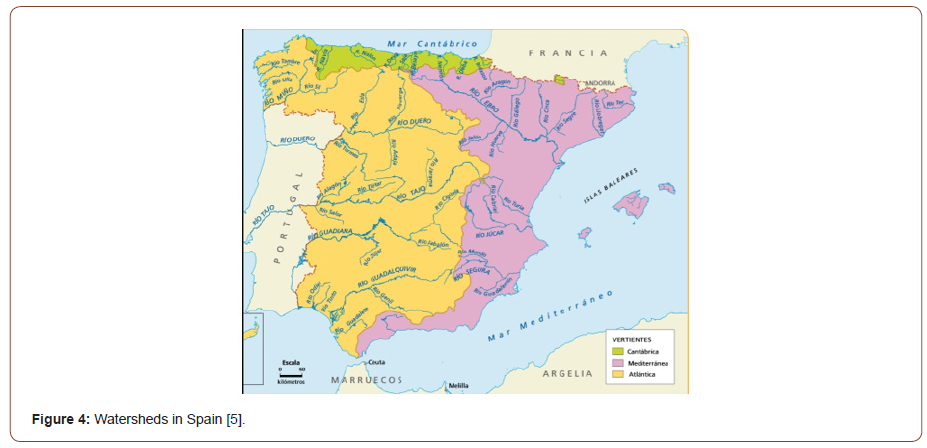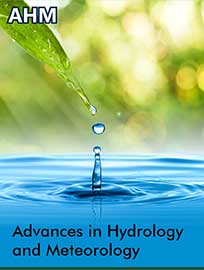 Mini Review
Mini Review
Water Supply in Greater Bilbao
Legarda F1, Alegría N1*, Peñalva I1, and Silveiro A2
1Energy Engineering Department, University of the Basque Country (UPV/EHU), 48013 Bilbao, Spain
2Ingider, 48013 Bilbao, Spain
Alegría N, Energy Engineering Department, University of the Basque Country, Spain.
Received Date: July 08, 2021; Published Date: July 21, 2021
Introduction
The town of Bilbao and the municipalities that make up its influence area, bathed most of them by the waters of River Nervión, are located in the north of the Iberian Peninsula, as shown in Figure 1 [2].
This urban area has a unique population density. It was known as the metropolitan area of Greater Bilbao and is it is also called the Bilbao Metropolitan Area nowadays. It comprises 30 towns that gather near one million residents, which represents 80 % of the population of the province of Bizkaia [3].
According to a continental climate, with soft winters and summers, it receives an annual accumulated rainfall of approximately 1200 mm (Figure 2).


In 1979, after the end of the dictatorship and together with the approval of the Constitution, Spain was divided into communities and these, in turn, into provinces, which constitute political delimitations with special characteristics. Bilbao is the capital of the province of Bizkaia, one of the three provinces that belong to the Community of the Basque Country.
The area that corresponds to the province of Bizkaia has a special feature: there are not reservoirs that can supply water to the population. As shown in Figure 3, Bilbao is located in the north region colored in white that has no water storage.
The management of the water in Spain is carried out by the confederations that are defined by the big basins: Duero, Tajo, Guadiana, Guadalquivir, Segura, Ebro and the one of the norths, that brings together all the basins of the rivers that flow into in the Cantabrian Sea. Figure 4 shows the rivers and the seas where these flow into according to the three possible watersheds.


In the region of Bizkaia, due to its orography and population, it has not been possible to store water in big quantities in order to supply the water needed by the residents for their life.
Therefore, in the 50s-60s two very important concessions were authorized to carry out water transfers from the Mediterranean basin to the Cantabrian basin. The first and most important one in terms of water supply is the water transfer from River Zadorra, located in the province of Araba, that provides between 70% and 80% of the water needed. The second one is the water transfer from River Cerneja, located in the province of Burgos, that reinforces the water supply regulated by River Ordunte, providing the remaining 20-30%.
Discussion
Zadorra-Arratia water transfer
This water transfer has its origin in one concession that was processed between 1925 and 1935 to use the transferred water for hydroelectric purposes and for supply of towns. Anyway, it was not until 1957 when the Zadorra-Arratia water transfer was built. This way, the water from a tributary of River Ebro that flows into the Mediterranean Sea was transferred to River Arratia that flows into the Cantabrian Sea. Two reservoirs, connected between them by an underground pipe, were built: Ulibarri-Ganboa with 146 hm3 and Urrunaga with 72 hm3.

The transferred flow rates regulated by these reservoirs are used to run turbines in Barazar hydroelectric power plant before discharging in River Arratia in their way to the Cantabrian Sea. From 1967 these same flow rates started to be used for the supply of Greater Bilbao (Bilbao Metropolitan Area nowadays) thanks to an agreement among the users. The average value of the transferred water is 120 Hm3/year, among which 100 Hm3/year are for water supply and 20 Hm3/year are surplus-water flows that are transferred in order to avoid floods in the city of Vitoria-Gasteiz. As a compensation, the reservoirs of River Zadorra return an ecological flow to the basin of 1,2 m3M/s in summer and 0,9 m3/s in winter. Thanks to this water transfer an average electricity production of 80 GWh/year is generated. Figure 5 shows a scheme of this water transfer.
Cerneja-Ordunte water transfer
In 1928 a Royal Law stablished that the town of Bilbao could manage the exploitation of River Ordunte and River Cerneja in Mena Valley. The water transfer from River Cerneja was built in 1961, providing 13 Hm3/year approximately to the reservoir of Ordunte for the supply of water to Bilbao. The capacity of this reservoir is 22 hm3 on an area of 48 km2. The dam-toe hydroelectric power plant located in this reservoir generates an average electricity production of GWh/year.
Conclusion
The economic and social development of the Bilbao Metropolitan Area, with noticeable industrial impact in the past years, would not had been possible if the water supply were not guaranteed thanks to the water transfer from the Zadorra system.
The planning that has been developed in Spain during the last years restricts the water transfers to the point that new water transfers are almost unfeasible, in most cases due to political interests. If these water supply needs had to be covered nowadays, desalination would play an important role. It is important to note that when considering a population close to one million residents, these desalination techniques, in particular the ones based on membranes technology, are less competitive and almost unviable due to the big quantity of energy that needs to be consumed for the water filtering processes and for reaching the consumption pressures.
Assuming that the cleanest energy is the one that is not used, the catchment of water resources in reservoirs that are located at elevated altitudes, do not need energy for the distribution and only a negligible quantity of energy will be needed for the treatment.
Acknowledgement
None.
Conflict of Interest
No conflict of interest.
References
- Geoportal Climate and Water of The National Atlas of Spain. Chapter 4.
- https://thumbs.dreamstime.com/z/europa-mapa-f%C3%ADsico-67598980.jpg
- http://www.conocerbilbao.com/gran-bilbao-o-el-area-metropolitana-de-bilbao/
- https://www.embalses.net/provincias.php
- https://www.cerebriti.com/juegos-de-geografia/mapa-rios-de-espana--vertiente-atlantica-con-afluentes
-
Legarda F, Alegría N, Peñalva I, Silveiro A. Water Supply in Greater Bilbao. Adv in Hydro & Meteorol. 1(1): 2021. AHM.MS.ID.000503.
-
Water transfer, Water supply, Water storage, Domestic, Industrial, Rainfall, Climate, Reservoirs
-

This work is licensed under a Creative Commons Attribution-NonCommercial 4.0 International License.






